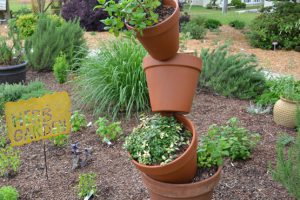
by Amy Mullins, PhD, RDN | May 31, 2019

Stay hydrated this summer.
Nothing is more refreshing on a hot summer day than an ice-cold glass of water! Water is an essential component to good health. In fact, it makes up 60% of your body’s weight and is involved in various metabolic processes throughout your body. Without it, you could not survive. As summer approaches, it is important to be mindful of the increasing temperatures outside since the chances for dehydration are much greater than other times of the year – especially if you are planning to spend a lot of time outdoors.
Dehydration happens when your body lacks enough water to carry out normal processes. It often occurs when you are expending more water (usually through sweat & exercise) than you are consuming, and is accelerated in warm humid climates. Dehydration is no joke, and can lead to serious medical complications such as heat stroke, heat stress, and even death. Common signs and symptoms that may indicate you are dehydrated include fatigue, headache, dry mouth, little to no urination, constipation, vomiting, muscle-weakness, dizziness, and lightheadedness. Most susceptible to heat stress and complications from dehydration include infants, older adults (65 & up), people who are overweight, and people who are excessive sweaters during physical activity. If you fall into any of those categories, try to be mindful about how much fluid you are consuming throughout the day.
How can you prevent dehydration?
While many people think they may be drinking enough, that is often not the case. Your own thirst mechanism isn’t always the best gauge to make sure you are properly hydrated. According to the National Academy of Medicine, women should consume an average of 9 ½ cups of water per day and men should be consuming 12 cups. For older adults over the age of 70, the rule of thumb is about 7 cups per day. That includes all fluids from water, coffee, and juices.
Keep in mind that needs may be different for each of us. One simple way to check your hydration status is to look at the color of your urine. If the color of your urine is a light lemonade color, you are in the clear! However, if your urine color is a dark orange, you need to start drinking some fluids to get back to a hydrated state to avoid any health complications.
Additional ways to reach your fluid intake without refilling your water bottle
Did you know water makes up the largest component of many of the foods we eat? By adding some more fruits and vegetables to your diet such as watermelon, strawberries, melons, oranges, broccoli, bell peppers, and lettuces – you are not only increasing your fluid intake but getting your necessary vitamins and minerals as well! According to the Dietary Guidelines for Americans, people should be consuming an average of 2 cups of fruits and vegetables per day.
Other factors that can influence your hydration status
Alcohol – Alcohol acts as a diuretic – meaning it turns down a hormone called antidiuretic hormone (ADH) which tells your kidneys to absorb/retain fluids. In other words, drinking a lot of alcohol will make you expel more fluids from your body. Make sure to drink extra water while enjoying alcoholic beverages to avoid becoming dehydrated.
Diet – Consuming a high-sodium diet is another cause of dehydration. Sodium is necessary in our diets, but only in very small amounts. When we consume excessive amounts of sodium, this disrupts the body’s filtration system and the kidneys begin holding onto more and more water. This leads to dehydration, bloating, edema, hypertension, and cardiovascular stress. Drinking extra water can help bring things back into balance and re-hydrate your thirsty cells!
Older Age – As we get older, thirst sensations decrease and risk for dehydration increases since older adults do not feel the need to drink as much. Additionally, many medications can influence fluid needs in the body.
Caffeine – Contrary to popular belief, caffeine does not dehydrate you. When you drink coffee, or other caffeinated beverages you are also consuming fluids. High fluid consumption leads to higher frequency of urination.
Learn to LOVE Water
Water by itself can definitely get old if it isn’t your beverage of choice. There are plenty of ways to add flavor and sweetness to your drinks without packing in tons of extra calories and sugar. Fruit infusions are a very simple way to make a boring beverage much more delicious. Try some of these delightful, thirst-quenching recipes!
Raspberry Orange Mint
- Water
- 1 cup raspberries
- 1 orange sliced up
- Mint leaves
Lemon Lime Thyme
- Water
- 1 lemon sliced
- 1 lime sliced
- 1 large sprig of fresh thyme
Blueberry Lemon Mint
- Water
- 1 cup blueberries
- 1 lemon sliced

by Dorothy C. Lee | May 25, 2019
Herbs are like people; each herb has its own personality. Some herbs have bold flavors and should be used with care while others are mild and can be used more freely. View Shopping for Health: Herbs and Spices for more about this.
Herbs can be divided into two categories. Accent herbs and herbs that add character to dishes. Parsley, chives, and dillweed are a few of the accent herbs. They are milder in flavor and are often combined within the same recipe. The character herbs; basil, marjoram, rosemary, bay leaves, thyme, sage, and tarragon add dominant flavor to dishes.

Getting to Know Herbs
Photo source: Beth Bolles
A little heat releases the flavor of herbs. Herbs are bitter, however, when cooked too much. Add accent herbs during the last few minutes of cooking time. Character herbs, such as bay leaves, can withstand longer cooking times and usually are added at the beginning of the cooking process.
When selecting fresh herbs, look for plants with an all-over green color. Yellowing indicates old plants, while black, watery areas are a sign of bruising.
To refrigerate fresh herbs for future use, rinse herbs under cold water, pat dry, wrap in paper toweling and refrigerate in a plastic bag. To use, just cut or pull off leaves. Most refrigerated herbs will retain freshness for up to four days to a week.
Herbs can be frozen or dried for longer storage. To freeze fresh herbs, wash herbs, pat dry and freeze in airtight bags or containers. Frozen herbs should be thawed just before use. Fresh herbs can be dried for later use.
When experimenting with a new herb, pull off a leaf and crush it, let it warm in your hand. If it has a delicate aroma you can add more. If it is strong and pungent, use it sparingly. It is always easier to add more of an herb than subtract.
Dried herbs are more concentrated. When cooking with dried herbs use one third of the dried leaves to substitute for the fresh. One teaspoon of dried leaves is equal to one tablespoon of fresh. The fresh leaves are more pungent than the dried.
Cooking with Herbs
Try these herb blends to enhance the flavor of beef, poultry, and seafood dishes.
Salt Free Blend
1 Tablespoon mustard powder
2 teaspoons parsley
2 teaspoons onion powder
2 teaspoons thyme
1 Tablespoon garlic powder
2 teaspoons dill weed
2 teaspoons savory
2 teaspoons paprika
1 teaspoons lemon peel
Garden Blend
3 Tablespoons dried parsley
3 Tablespoons dried basil
3 Tablespoons dried thyme
3 Tablespoons dried marjoram
3 Tablespoons dried rosemary
3 Tablespoons dried chives
3 Tablespoons paprika
½ teaspoon garlic powder
“What is paradise, but a garden of herbs full of pleasure and nothing there but delights”
William Lawson, 1617

by Angela Hinkle | May 6, 2019
Spring has sprung! Have you? One way to shake off those groggy winter hibernation feelings is to Put a Little Step In Your Spring.
Regular Brisk Walking
- Means you can talk but maybe not sing. You may be slightly out of breath.
- Improves overall health.
- Can help you maintain a healthy weight.
- Prevents chronic health conditions including heart disease, high blood pressure, and type 2 diabetes.
- Strengthens bones.
- “Boosts” or increases muscle power and endurance.

Ready to walk to the top (of Mt Vesuvius) Photo Source: Richard Waid
Strive for 10,000 Steps a Day
- Spring clean your house.
- Mow the lawn.
- Dance around your living room.
- Take the stairs.
- Park in the farthest spot in the parking lot from your destination.
- Wear a pedometer or electronic fitness device to measure how many steps you’ve gone.
- Try for at least 30 minutes a day. If you can’t – break up your walking into smaller segments.
- Vary your intensity – speed up, slow down. Then repeat.
- Vary the view. Try different settings to walk – your neighborhood, the beach, or the woods.
Make It Social
- Let your dog take you for a walk. (Be sure to bring cleanup bags with you and have your best friend(s) on a leash.)
- Walk with friends.
- Make it a family routine.
- Join a walking club.
- Compete with a group to see who can get the most steps.
- Walk in the mall or a park. And say hello to people as you pass by.
- Mindful walk – notice the colors around you, how your feet feel as they step down on different surfaces, the variety of sounds you hear on your walk. Meet someone along the way. Learn their name…and remember it. For info on mindfulness, check out this UF/IFAS publication: Mindfulness: An Introduction.
Always remember to walk in a safe environment, wear comfortable walking shoes, and check with your medical provider for the best walking strategies for you.
So this spring, see how the flowers pop in color. Hear all the different sounds the birds make or enjoy some of your favorite music. Feel the wind and sun on your face. You can do all that and more when you Put a Little Step in Your Spring.

by Melanie Taylor | May 6, 2019

Hanging with friends at 4-H Camp. Melanie Taylor as a 4-H Teen Counselor (right). Photo source: Melanie Taylor
Spring is upon us and 4-H Summer Camp preparations are in full swing. As a 4-H Agent preparing for our week of county 4-H camp, my days are busy with phone calls and emails from parents, teen counselor trainings, adult volunteer screenings, paperwork, paperwork, and more paperwork. Although this is a very busy time for me as a 4-H Agent, it also allows me to reflect on why I chose this career path and why there is a sense of nostalgia as I prepare for 4-H camp.
I attended 4-H camp in Virginia, where I grew up, every year from age 9-18. I was a camper who grew into a counselor-in-training and then a counselor. Those weeks of 4-H camp were filled with hot days and warm nights, but it was worth it all for the memories I will have for a lifetime. I can still smell the cafeteria food and hear the sounds in the gymnasium as kids played basketball and pounded at their leathercraft projects. I can feel the chills I would get as the entire camp sang around the campfire circle and patiently waited for the canoe to land on the lake’s edge; the camp staff would carry a flame as they entered the campfire circle and ceremoniously light the fire. Most importantly, I am still connected with my 4-H camp friends through social media and/or as close friends and we continue to share our old, blurry camp pictures from the 1990’s each year on Facebook.

Morning flag raising ceremony at Camp Timpoochee. Photo source: UF/IFAS Northwest District
So, as I work hard to prepare camp for my county campers and teen counselors, I want to create similar memories for them. In ten, twenty, and thirty years from now, I want them to think back on the fun moments they experienced in the Florida 4-H camping program. I also want them to form friendships and make camp connections for a lifetime, whether it is learning to kayak, fish, make arts and crafts, cook over a campfire, sing camp songs, etc.
With all of this said, I hope you as parents will consider giving your child(ren) these special moments. The days will be long, but fun, and their nights will be filled with campfires and hanging out with friends. When they arrive home on Friday, they will be exhausted, but so excited to share all of the camp songs with you (prepare yourself for lots of loud, enthusiastic singing). They will have new friends they want you to meet and they will tell you camp stories they will always cherish.
In Northwest Florida, there are two 4-H Camps, Camp Cherry Lake in Madison and Camp Timpoochee in Niceville. Each county in these camping districts has one county week of camp each summer. Contact your local UF/IFAS Extension Office now to find out the details and register your child for a week of fun and memories.

Northwest Florida 4-H Camp Dates 2019. Photo source: UF/IFAS Extension

by Heidi Copeland | Apr 30, 2019

The Consumer Financial Protection Bureau, (CFPB) has defined financial capacity as a the combination of attitude, knowledge, skills, and self-efficacy needed to make and exercise money management decisions that best fit the circumstances of one’s life, within an enabling environment that includes, but is not limited to, access to appropriate financial services.
Many of the attitudes, knowledge and skills needed to build financial capacity can be learned. People learn behavior through a variety of contexts. Children, in particular, learn through practices modeled by a parent or caregiver. In fact, research shows that parents and caregivers have the most influence on their children’s financial capability.
If you are like most parents, you probably recognize this—and you are interested in setting your kids on a good path toward financial well-being. However, many parents also say they do not always have time, tools, or personal confidence to start talking about money thinking their children will learn about it in school, later on, when they are old enough to understand.
This is most unfortunate. According to the Council for Economic Education 2018 Survey of the States, only 17 States require high school students to take a course in personal finance. So, if a parent isn’t teaching their children basic money/financial skills who is? Economical and financial literacy is a foundational element to achieving financial health and financial well-being. It is never too early (or too late) to start building this.
Talking to children about money, even in EARLY CHILDHOOD, helps children build the skills they need later in life. Early childhood education experts like to call this scaffolding. You are setting the framework…the support…the platform, encouraging financial capability milestones from early childhood into young adulthood. Children can learn the behaviors, knowledge, skills, and personal characteristics that support financial health and well-being.
Books can help start these critical early conversation. The CFPB has made it EASY! Parents can be their child’s first financial capability teacher! The University of Wisconsin-Extension Family Living Programs and the University of Wisconsin-Madison Center for Financial Security have selected books for the CFPB Money as you Grow Book Club. This program uses easy to read and understand children’s books to discuss money concepts. These books include many favorites:
- A Bargain for Frances, by Russell Hoban
- A Chair for My Mother, by Vera Williams
- Alexander, Who Used to Be Rich Last Sunday, by Judith Viorst
- Count on Pablo, by Barbara deRubertis
- Cuenta con Pablo, by Barbara deRubertis
- Curious George Saves His Pennies, by Margaret and H.AS. Rey
- Just Shopping With Mom, by Mercer Mayer
- Lemonade in Winter, by Emily Jenkins
- My Rows and Piles of Coins, by Tololwa M. Mollel
- Ox-Cart Man, by Donald Hall
- Sheep in a Shop, by Nancy Shaw
- The Berenstain Bears & Mama’s New Job, by Stan & Jan Berenstain
- The Berenstain Bears’ Trouble With Money by Stan and Jan Berenstain
- The Purse, by Kathy Caple
- The Rag Coat, by Lauren Mills
- Those Shoes, by Maribeth Boelts
- Tia Isa Wants a Car, by Meg Medina
- Tia Isa Quiere un Carro, by Meg Medina
Fortunately, many of the building blocks for good financial decision making – like self-regulation, patience, planning, and problem-solving – do not require a lot of financial know-how.
Reading books with children is a creative way to learn about the many sides of money management. Pick up a few of the titles at your local library and influence your children’s financial capability. Building good habits leads to a life of good financial health and well-being.
Example of key ideas from reading books:
| PLANNING |
How Children Show It |
| Making Decisions |
Can look at a few choices and select on what will bring the best results. |
| Setting Goals |
Can follow a multi–step plan. |
| Prioritizing |
Can prioritize choices when they want two or more things at once. |
| Solving problems
|
Can describe problems and come up with a few idea to make things better. |
| MONEY |
|
| Earning |
Can identify the different jobs people in the family and in the community do to earn money and keep it safe. |
| Spending |
Make spending choices with their own money – real or play. |
| Saving |
Keeps money in a safe place and keeps track of amount saved for future spending. |
| Sharing and borrowing |
Can explain the difference between lending and giving something away. |
| ME |
|
| Self-control |
Can talk about times when they were able to wait and how they were able to do it. |
| Follow-through |
Can identify who they can turn to for help reaching a goal, or what tools or tricks might help them stick with a plan. |
| Staying true to yourself |
Name one special thing they like about themselves and their loved ones. |
| Flexibility |
Can talk about a time when their plans did not turn out how they wanted and what they did instead. |
Resource: https://www.consumerfinance.gov/consumer-tools/money-as-you-grow/

by Samantha Kennedy | Apr 25, 2019
As we get older, our risk of falling increases. In fact, falling once doubles the chances of falling again. According to the Centers for Disease Control and Prevention (CDC), one out of five falls causes serious injury such as broken bones or head injury. Over 300,000 people aged 65 or older are hospitalized each year for hip fractures caused by falls.

Properly installed handrails in bathrooms and other high traffic areas can greatly reduce the risk of falling. (Photo source: Samantha Kennedy)
Most fall injuries occur in the home. We think of our homes as our safe space and sanctuary, often overlooking potential dangers. Here are six common hazards that occur in the home that can contribute to an increased risk of falling.
Clutter. Items that block or limit walkways in the home can be tripping hazards. Having to navigate around excess furniture or boxes can be difficult for someone with limited mobility. Clear out the clutter and keep walkways free of extraneous items. Wide open hallways and other spaces in the home will reduce potential tripping hazards.
Rugs. Rugs large and small can be tripping hazards. People can catch their toes underneath a rug’s edge or the rug itself can slip out from under them, causing a fall. Remove any rugs that are not necessary, such as rugs set out strictly for decoration. Apply slip-resistant backing to rugs to keep them from sliding across the floor.
Lighting. Dim lighting can make it difficult to see potential tripping hazards. Install brighter lights, especially in walkways and stairwells. Use nightlights in hallways and bathrooms to help navigate more easily at night.
Storage. Many falls occur when people are trying to reach items that are stored out-of-reach. Rearrange items, especially those used most often, in cabinets and on shelves so they can be reached easily without needing a step ladder.
Handrails. The lack of handrails or handrails that are broken or installed incorrectly can contribute to falls. The extra support and stability provided by handrails is vital, especially for those with limited mobility. Installing proper handrails in the bathroom (including the toilet and shower) and on stairs can greatly reduce the risk of falling.
Pets. Small pets can contribute to falls by inadvertently acting as a tripping hazard. Be aware of where pets are and tread carefully around them. When walking a pet, keep them on a tight leash and do not let them wrap around feet or legs.
Another great way to help reduce the risk of falling is through exercise. Strength and balance exercises such as Tai Chi help improve leg strength, balance, and flexibility. Some people also may benefit from calcium and vitamin D supplements, which can improve bone strength. Always consult a physician before taking any supplement.
Related articles:
Important Facts about Falls (CDC)
Fall Prevention (UF/IFAS Extension)
Extension classes are open to everyone regardless of race, creed, color, religion, age, disability, sex, sexual orientation, marital status, national origin, political opinions or affiliations.














